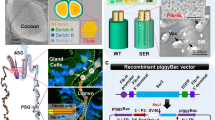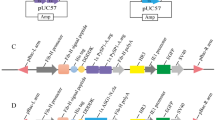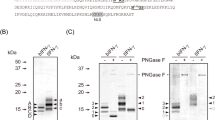Abstract
We describe the generation of transgenic silkworms that produce cocoons containing recombinant human collagen. A fusion cDNA was constructed encoding a protein that incorporated a human type III procollagen mini-chain with C-propeptide deleted, a fibroin light chain (L-chain), and an enhanced green fluorescent protein (EGFP). This cDNA was ligated downstream of the fibroin L-chain promoter and inserted into a piggyBac vector. Silkworm eggs were injected with the vectors, producing worms displaying EGFP fluorescence in their silk glands. The cocoons emitted EGFP fluorescence, indicating that the promoter and fibroin L-chain cDNAs directed the synthesized products to be secreted into cocoons. The presence of fusion proteins in cocoons was demonstrated by immunoblotting, collagenase-sensitivity tests, and amino acid sequencing. The fusion proteins from cocoons were purified to a single electrophoretic band. This study demonstrates the viability of transgenic silkworms as a tool for producing useful proteins in bulk.
This is a preview of subscription content, access via your institution
Access options
Subscribe to this journal
Receive 12 print issues and online access
$209.00 per year
only $17.42 per issue
Buy this article
- Purchase on Springer Link
- Instant access to full article PDF
Prices may be subject to local taxes which are calculated during checkout





Similar content being viewed by others
References
Ramshaw, J.A.M., Werkmeister, J.A. & Glattauer, V. Collagen-based biomaterials. Biotechnol. Genet. Eng. Rev. 13, 335–382 (1996).
Sano, A., Hojo, T., Maeda, M. & Fujioka, K. Protein release from collagen matrices. Adv. Drug Deliv. Rev. 31, 247–266 (1998).
Cooperman, L. & Michaeli, D. The immunogenicity of injectable collagen. I. A 1-year prospective study. J. Am. Acad. Dermatol. 10, 638–646 (1984).
Tamura, T. et al. Germline transformation of the silkworm Bombyx mori L. using a piggyBac transposon-derived vector. Nat. Biotechnol. 18, 81–84 (2000).
Lees, L.F. & Bulleid, N.J. The role of cysteine residues in the folding and association of the COOH-terminal propeptide of types I and III procollagen. J. Biol. Chem. 269, 24354–24360 (1994).
Horn, C. & Wimmer, E.A. A versatile vector set for animal transgenesis. Dev. Genes Evol. 210, 630–637 (2000).
Rubin, G.M. & Spradling, A.C. Genetic transformation of Drosophila with transposable element vectors. Science 218, 348–353 (1982).
Handler, A.M. & Harrell II, R.A. Germline transformation of Drosophila melanogaster with the piggyBac transposon vector. Insect Mol. Biol. 8, 449–457 (1999).
Peloquin, J.J., Thibault, S.T., Staten, R. & Miller, T.A. Germ-line transformation of pink bollworm (Lepidoptera: Gelechiidae) mediated by the piggyBac transposable element. Insect Mol. Biol. 9, 323–333 (2000).
Nolan T., Bower, T.M., Brown, A.E., Crisanti, A. & Catteruccia, F. piggyBac-mediated germline transformation of the malaria mosquito Anopheles stephensi using the red fluorescent protein dsRED as a selectable marker. J. Biol. Chem. 277, 8759–8762 (2002).
Grzelak, K. Control of expression of silk protein genes. Comp. Biochem. Physiol. 110, 671–681 (1995).
Bulleid, N.J., Wilson, R. & Lees, J.F. Type-III procollagen assembly in semi-intact cells: chain association, nucleation and triple-helix folding do not require formation of inter-chain disulphide bonds but triple-helix nucleation does require hydroxylation. Biochem. J. 317, 195–202 (1996).
Berg, R.A. & Prockop, D.J. The thermal transition of a non-hydroxylated form of collagen. Evidence for a role for hydroxyproline in stabilizing the triple-helix of collagen. Biochem. Biophys. Res. Commun. 52, 115–120 (1973).
Vuorela, A., Myllyharju, J., Nissi, R., Pihlajaniemi, T. & Kivirikko, K.I. Assembly of human prolyl 4-hydroxylase and type III collagen in the yeast Pichia pastoris: formation of a stable enzyme tetramer requires coexpression with collagen and assembly of a stable collagen requires coexpression with prolyl 4-hydroxylase. EMBO J. 16, 6702–6712 (1997).
John, D.C.A. et al. Expression of an engineered form of recombinant procollagen in mouse milk. Nat. Biotechnol. 17, 385–389 (1999).
Tomita, M. et al. Biosynthesis of recombinant human pro-α1(III) chains in a baculovirus expression system: production of disulphide-bonded and non-disulphide-bonded species containing full-length triple helices. Biochem. J. 312, 847–853 (1995).
Tomita, M., Kitajima, T. & Yoshizato, K. Formation of recombinant human procollagen I heterotrimers in a baculovirus expression system. J. Biochem. 121, 1061–1069 (1997).
Ruggiero, F. et al. Triple helix assembly and processing of human collagen produced in transgenic tobacco plants. FEBS Lett. 469, 132–136 (2000).
Shimura, K. Biochemical aspects on fibroin. Tanpakushitsu Kakusan Koso 24, 1324–1335 (1979).
Kikuchi, Y., Mori, K., Suzuki, S., Yamaguchi, K. & Mizuno, S. Structure of the Bombyx mori fibroin light-chain-encoding gene: upstream sequence elements common to the light and heavy chain. Gene 110, 151–158 (1992).
Yamaguchi, K. et al. Primary structure of the silk fibroin light chain determined by cDNA sequencing and peptide analysis. J. Mol. Biol. 210, 127–139 (1989).
Acknowledgements
We thank Dr. Ernst A. Wimmer of Universität Bayreuth for kindly providing us with pBac[3xP3-EGFPafm] and Dr. Shigeki Mizuno at Nihon University and Dr. Satoshi Inoue at the National Institute of Agrobiological Sciences for kindly providing anti-fibroin L-chain antibodies.
Author information
Authors and Affiliations
Corresponding author
Ethics declarations
Competing interests
The authors declare no competing financial interests.
Rights and permissions
About this article
Cite this article
Tomita, M., Munetsuna, H., Sato, T. et al. Transgenic silkworms produce recombinant human type III procollagen in cocoons. Nat Biotechnol 21, 52–56 (2003). https://doi.org/10.1038/nbt771
Received:
Accepted:
Published:
Issue Date:
DOI: https://doi.org/10.1038/nbt771
This article is cited by
-
Collagen-Based Medical Devices for Regenerative Medicine and Tissue Engineering
Applied Biochemistry and Biotechnology (2023)
-
Ectopic expression of sericin enables efficient production of ancient silk with structural changes in silkworm
Nature Communications (2022)
-
Application of biotechnology in sericulture: Progress, scope and prospect
The Nucleus (2022)
-
Thermochromic Silks for Temperature Management and Dynamic Textile Displays
Nano-Micro Letters (2021)
-
In vitro assessment of antitumor immune responses using tumor antigen proteins produced by transgenic silkworms
Journal of Materials Science: Materials in Medicine (2021)



